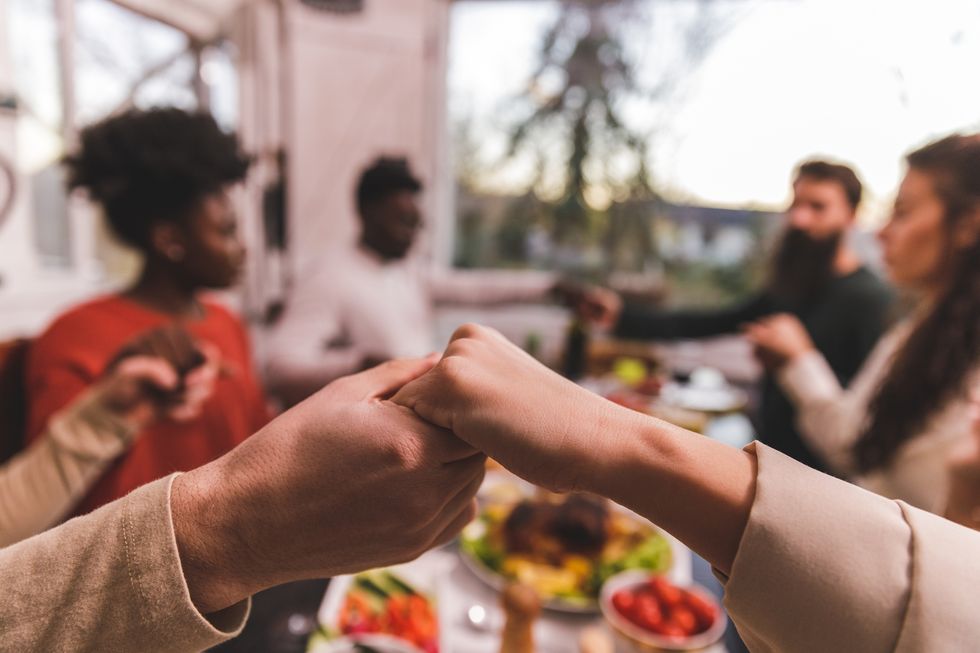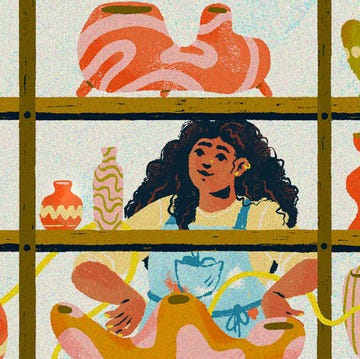Caring for our mental health is more essential than ever before. The way we treat our bodies, how and with whom we spend our time, and what thoughts take center stage in our minds are vital. In the monthly Shondaland series A Path to Well-Being, we’re sharing science and strategies to help you better understand and manage your well-being.
Anyone who was taught to say grace as a kid or has sent a thank-you note knows that it feels good to be grateful. We should be thankful for what we have in life and count our blessings. But what makes gratitude so beneficial for us? And how can we summon that feeling if it doesn’t come naturally?
Gratitude is actually an innate human capacity that can be cultivated with practice, explains Emiliana Simon-Thomas, science director of the Greater Good Science Center at the University of California, Berkeley, where she runs an initiative that studies Expanding the Science and Practice of Gratitude.
“Every person is born with a potential and a disposition towards experiencing gratitude,” Simon-Thomas says. “It’s an evolved quality of our mental lives that supports and sustains our collective living as an ultra-social species. We need gratitude.”
While it’s great to go around the Thanksgiving dinner table and share what we’re grateful for this year, it’s better for our brains and bodies to make gratitude a regular, ongoing part of our daily routines.
Gratitude is both a state and a trait, Simon-Thomas says. The state of gratitude is feeling thankful in the moment for something received, whether a kind gesture like holding the door open for someone or seeing a beautiful sunset. Then, there’s the trait of gratitude, which is more of a general disposition toward thankfulness where one experiences the world through a lens of appreciation, automatically tuning in to and savoring the good in their lives.
Regularly practicing the state of gratitude — intentionally noticing and being thankful for life’s gifts and pleasures — helps develop the trait, Simon-Thomas explains. “If you’re trying to become a more grateful person,” she says, “it takes infusing your moments of a given day with little moments of gratitude. If you experience gratitude frequently, you’ll just experience it more readily moving through the world.”
In other words, the more you do it, the easier it gets. Feeling thankful more often isn’t only about developing a sunnier outlook, although that’s one of the perks. Cultivating a grateful disposition actually delivers significant mental and physical health benefits, including reducing stress and improving outcomes for people with heart disease and other chronic illnesses.
Because gratitude points us toward the goodness in our lives, it boosts our experience of positive emotions, making us feel more connected to others. Gratitude also brings an aspect of “self-transcendence” that buffers negative mental patterns, according to Simon-Thomas.
“One of the biggest challenges that we face in our mental lives is potentially falling prey to self-conscious rumination about what makes us feel inadequate, or what might be threatening us, or whatever else is on the list of worries and hassles in our lives that are really about ourselves,” Simon-Thomas says. “Gratitude invites us out of that.”
Gratitude isn’t a panacea, but it builds resilience, which makes it easier to bounce back from setbacks. “The point is not to claim that gratitude solves all of life’s challenges or makes it such that you’ll never encounter something tragic or dramatically unpleasant,” says Simon-Thomas, who adds that gratitude can make us better equipped to recover, manage, and grow from bad experiences. Need new ways to express gratitude? Try these science-backed strategies.
Be more specific
Studies show that gratitude is more powerful when we recognize the benefits of the act, how it took effort, and was intentionally extended. “These three things,” Simon-Thomas says, “supersize gratitude.”
Simon-Thomas’ favorite gratitude intervention is a three-part thank you, which she describes as a “specific and complete” way to acknowledge kindness. Instead of merely saying thanks, be specific about what the other person did and the energy and intention behind the gesture.
For instance, “Thanks for baking a cake for my birthday” would be stronger as: “Thanks for baking a cake for my birthday because you could have easily picked one up from the bakery, but it means so much to me that you took the time in your own kitchen to whip up something special in my favorite flavor. I feel so loved and appreciated.”
Simon-Thomas says expressing thanks in a much more detailed way, whether verbally or in writing, “infuses the moment — for both people — with greater feelings of closeness and connection.”
Write a letter
A deeper rendition of a thank-you card, a gratitude letter is a chance to go into detail about how another person has impacted your life. “You get to be more descriptive and explanatory,” Simon-Thomas says, “and [can] be more creative in really dwelling on how valuable this other person has been in forming and shaping the life that you enjoy.”
Writing a gratitude letter is a “wonderful exercise in appreciation,” Simon-Thomas says. For an extra boost, reading it to the recipient in person or virtually will make the experience more powerful. It’s affirming for the recipient and renews both people’s sense of connection, purpose, and willingness to act on behalf of others. Expect tears.
Start a journal
Keeping a gratitude journal is a simple yet profound way to boost well-being and strengthen your gratitude muscle. It’s easy: Spend a bit of time throughout the week reflecting on what you’re thankful for, and write it down. You can jot it in your phone, a notebook by the bed, or in a fancy hardbound book with “GRATITUDE” embossed in gold on the front.
The point is to do it regularly and be specific about what you truly appreciate — not just “my partner,” but “the way my partner listens to me when I need support.” If practicing gratitude is new for you or feels uncomfortably personal — even in your own private journal — it’s totally fine to start with thankfulness for things.
“It’s really important to not be too heavy-handed with gratitude and allow people a lot of space and flexibility around how they get started or where they want to focus,” Simon-Thomas says. “Sometimes it starts with, ‘I’m grateful for my soft pillow,’ and the practice grows from there.”
Simon-Thomas notes that something as simple as being thankful for a soft pillow can transform into gratitude for the restful sleep it fosters, which allows you to be a more present parent. Then, you might feel gratitude for the creator of the pillow, the birds whose feathers made it so soft, and for all the different people it took to get that pillow into your hands and onto your bed.
“At some point,” Simon-Thomas says, “it just becomes almost overwhelming how lucky we are, how fortunate we are, how provided for we are, even though we could also go through a month and never consider any of that.”
Sandy Cohen is a Southern California-based writer, health and wellness coach, and host of the Inner Peace to Go podcast. Follow her on Twitter @YouKnowSandy.
Get Shondaland directly in your inbox: SUBSCRIBE TODAY

















